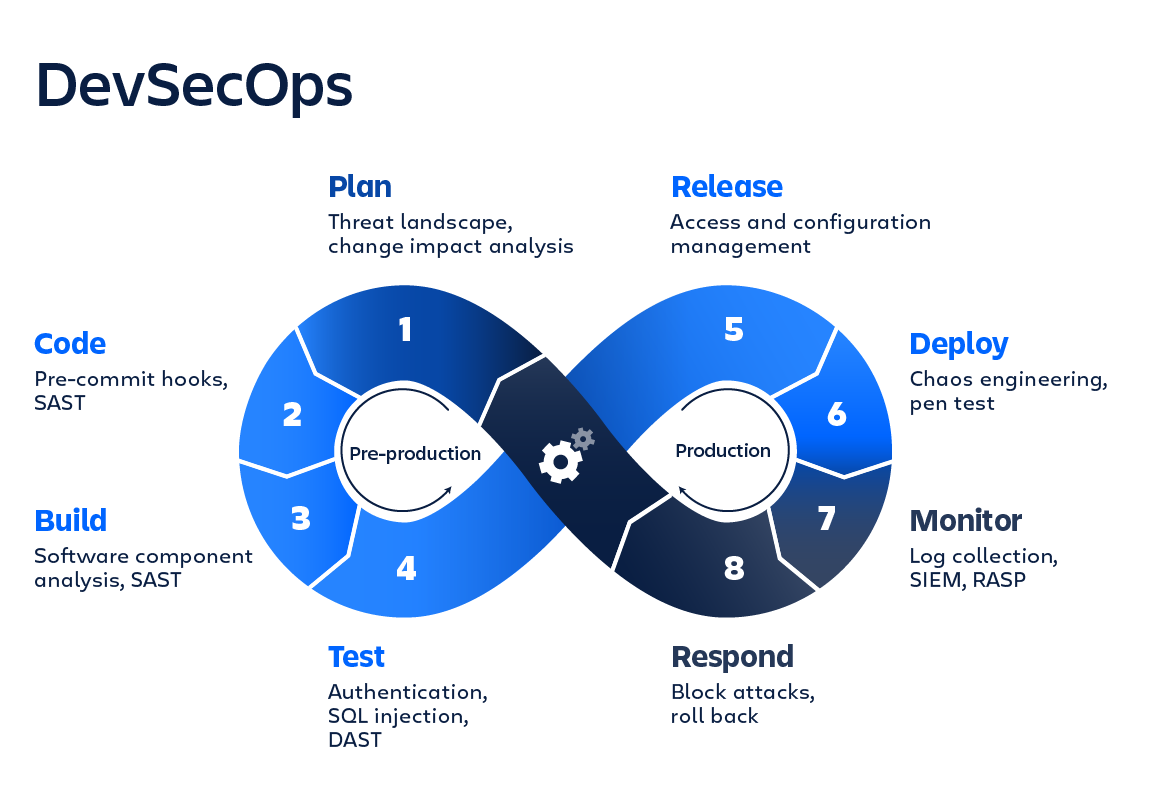Revolutionize Your Software Development with the Power of DevSecOps Tools
What is DevSecOps and tools needed to implement it

DevSecOps Tool: The Cornerstone of Secure and Agile Software Development In today's fast-paced digital landscape, where software is at the heart of business success, the importance of DevSecOps cannot be overstated.
As organizations strive to deliver high-quality, secure, and responsive applications, the integration of security practices into the software development lifecycle has become a crucial imperative.
DevSecOps tool, the seamless fusion of development, security, and operations, is the key to unlocking the full potential of modern software development.
By embedding security considerations from the outset, organizations can mitigate risks, enhance the resilience of their systems, and accelerate the delivery of innovative products and services.Through the adoption of DevSecOps tool, development teams can proactively identify and address vulnerabilities, ensuring that security is not an afterthought but a core component of the development process.</p>
This holistic approach enables organizations to build a culture of shared responsibility, where security is everyone’s concern, and collaboration across teams is the foundation for success.
Moreover, DevSecOps empowers organizations to respond swiftly to emerging threats, continuously monitor and adapt their security posture, and maintain regulatory compliance – all while driving agility and innovation.
By embracing this transformative approach, businesses can gain a competitive edge, protect their valuable assets, and build trust with their customers in the ever-evolving digital landscape.
Top DevSecOps Tools to Secure Your Software Development Pipeline
DevSecOps Tools to Secure Your Software Development Pipeline
As software development cycles continue to accelerate, it’s more important than ever to ensure security is built into every stage of the process. DevSecOps, the integration of security practices throughout the entire software development lifecycle, is crucial for protecting your applications and infrastructure.

To help you get started, here are the top DevSecOps tools you should consider implementing based on the software development pipeline stage:
- Plan: Requirements and planning (JIRA)
- Code: Static Application Security Testing (SAST) tools – Analyze source code to identify security vulnerabilities early in development, allowing you to address issues before they reach production. Examples of SAST tools are GitHub Advanced Security, CodeQL, Fortify and Checkmarx.
- Build: Also using Static Analysis Security Testing (SAST) at this stage.
- Test: Dynamic Application Security Testing (DAST) – Analyzes running applications in real-time. It identifies potential vulnerabilities not always apparent in static code analysis. Focuses on identifying threats and vulnerabilities from an outsider’s perspective. An example of DAST is OWASP ZAP.
- Release: The application code should have undergone extensive testing when the DevSecOps cycle is released. The stage focuses on protecting the runtime environment architecture by reviewing environment configuration values, including user access control, network firewall access, and personal data management. In the release phase, configuration management solutions are a crucial security component. Examples are Terraform, Docker, Ansible, Chef, and Puppet.
- Deploy: The deploy stage is a good time for runtime verification tools such as Osquery, Falco, and Tripwire.
- Monitor: It is crucial to put in place a robust continuous monitoring tool that operates in real-time to avoid any breaches. Examples of tools are SIEM (Security Information and Event Management) and RASP (Runtime Application Self-Protection).
- Operation / Respond: Maintaining release archives to quickly roll back if needed. Examples of tool is Infrastructure as Code (IaC) security scanners: IaC security tools analyze your configuration files to detect infrastructure misconfigurations that could lead to security risks.
By incorporating these DevSecOps tools into your software development lifecycle, you can shift security left, empowering your development teams to build secure applications from the ground up.
Invest in DevSecOps today to protect your organization’s digital assets.
Seamlessly Integrating DevSecOps Tools into Your Development Workflow
Seamlessly Integrating DevSecOps Tools into Your Development Workflow
Adopting a DevSecOps approach is no longer a nice-to-have, but a necessity in today’s fast-paced software development landscape. By seamlessly integrating security practices throughout the entire software development lifecycle, you can build a culture of shared responsibility and deliver secure, high-quality products faster than ever before.
The key to successful DevSecOps implementation lies in choosing the right tools and integrating them seamlessly into your existing development workflow. From static code analysis to infrastructure-as-code security scanning, there are a wealth of powerful DevSecOps tools available to help you shift security left and empower your development teams.
By investing in the right DevSecOps tools and processes, you can ensure that security is baked into every stage of development, from planning and coding to testing and deployment. This not only reduces the risk of vulnerabilities and breaches, but also enables your teams to work more efficiently and deliver value to customers more quickly.
Don’t get left behind in the race to adopt DevSecOps best practices. Explore the latest DevSecOps tools and strategies, and learn how you can integrate them into your development workflow to drive innovation, improve security, and stay ahead of the competition.
How DevSecOps Tools Can Improve Your Application Security and Compliance
DevSecOps Tools: Enhancing Application Security and Compliance
DevSecOps is the future of secure software development, seamlessly integrating security practices throughout the entire application lifecycle. By leveraging powerful DevSecOps tools, organizations can significantly improve their application security posture and ensure regulatory compliance.
These tools automate security testing, vulnerability scanning, and compliance monitoring, empowering development teams to address security concerns early on. With DevSecOps, security is no longer an afterthought, but a fundamental part of the development process.
Implementing DevSecOps tools can provide a range of benefits, including:
- Continuous Security Monitoring: Automated scanning and testing identify vulnerabilities and misconfigurations in real-time, allowing for prompt remediation.
- Streamlined Compliance: DevSecOps tools integrate compliance requirements, ensuring that applications meet industry standards and regulatory guidelines.
- Accelerated Time-to-Market: By integrating security into the development pipeline, organizations can deliver secure applications faster, without compromising quality.
- Improved Collaboration: DevSecOps fosters a culture of shared responsibility, where developers, security experts, and operations teams work together to enhance application security.
Embracing DevSecOps tools is a strategic move that can significantly strengthen your organization’s application security and compliance posture, ultimately protecting your business and customers from cyber threats.
5 Real-World Success Stories of Businesses Thriving with DevSecOps Tools
Businesses Thriving with DevSecOps Tools: 5 Real-World Success Stories
The rise of DevSecOps has revolutionized the way organizations approach software development and deployment. By seamlessly integrating security practices throughout the entire software lifecycle, DevSecOps has empowered businesses to build and deliver secure, high-quality applications faster than ever before.
Don’t just take our word for it – let’s explore five real-world success stories that showcase the transformative power of DevSecOps tools:
-
- Fintech Innovator Reduces Compliance Risks by 30% with Automated Security Scanning
- Retail Giant Cuts Application Release Time by 50% through Continuous Integration and Deployment
- Healthcare Provider Improves Patient Data Protection with Centralized Security Monitoring
- SaaS Startup Scales Efficiently and Securely with Infrastructure as Code
- Manufacturing Firm Mitigates Vulnerabilities 70% Faster with Vulnerability Management Automation
These examples demonstrate how DevSecOps enables organizations across industries to accelerate innovation, enhance security, and drive measurable business results. If you’re ready to experience the benefits of DevSecOps for your own company, the time to act is now.
Start Your DevSecOps Journey Today: Unlock the Full Potential of Your Software Development
DevSecOps: The Key to Unlocking Unparalleled Software Development
Embracing DevSecOps is no longer a choice, but a necessity in today’s fast-paced, highly competitive software landscape. By integrating security seamlessly into your development and operations processes, you can unlock unprecedented efficiency, agility, and resilience in your software delivery.
Gone are the days when security was an afterthought, slowing down your development cycles and compromising your competitive edge. DevSecOps empowers you to build security into every stage of your software development life cycle, ensuring that your applications are not only cutting-edge, but also impenetrable to cyber threats.
The benefits of adopting a DevSecOps approach are manifold. You’ll enjoy faster time-to-market, reduced operational costs, and enhanced customer trust – all while maintaining the highest standards of security and compliance. It’s a win-win situation that no forward-thinking organization can afford to ignore.
What to do next?
Explore each of the applications such as GitHub Advanced Security, OWASP and others. Only by running a Proof Of Concept, you will experience those applications in action.
DevSecOps F.A.Q
A: DevSecOps stands for Development, Security, and Operations.
It is an approach that integrates security practices within the DevOps process.
The goal is to ensure that security is a shared responsibility throughout the entire software development lifecycle, from planning and coding to deployment and maintenance.
A: DevSecOps is important because it embeds security into every phase of the development process, reducing the risk of vulnerabilities and ensuring faster, more secure software delivery.
It helps organizations proactively address security issues, comply with regulations, and protect against cyber threats.
A: Traditional security practices often involve security checks at the end of the development cycle.
In contrast, DevSecOps integrates security throughout the entire process, enabling continuous assessment and mitigation of security risks.
This shift-left approach ensures that security issues are identified and resolved early, reducing costs and delays.
A: The key principles of DevSecOps include:
- Security as code: Automating security practices within the CI/CD pipeline.
- Continuous monitoring: Regularly checking for vulnerabilities and compliance.
- Collaboration and communication: Ensuring all teams (development, security, operations) work together.
- Automation: Using tools to automate security testing and compliance checks.
A: Organizations can implement DevSecOps by:
- Shifting security practices left in the development process.
- Training development and operations teams on security best practices.
- Automating security tests and integrating them into the CI/CD pipeline.
- Adopting a culture of continuous improvement and collaboration.
- Using appropriate tools to facilitate security automation and monitoring.
A: Challenges in adopting DevSecOps include:
- Cultural resistance to change.
- Lack of security expertise among development teams.
- Integration complexities with existing tools and processes.
- Balancing speed and security in the development lifecycle.
- Ensuring continuous compliance with regulatory requirements.
DevSecOps tool enhances the CI/CD pipeline by embedding security checks at each stage, from code commits to deployment. It ensures that vulnerabilities are detected and addressed early, enabling secure, continuous delivery of software. This integration reduces the risk of deploying insecure applications and improves overall software quality.
A: Best practices to implement DevSecOps include:
- Automate security testing and integrate it into the CI/CD pipeline.
- Foster collaboration between development, security, and operations teams.
- Conduct regular security training and awareness programs.
- Continuously monitor applications and infrastructure for vulnerabilities.
- Implement a feedback loop to learn from incidents and improve security practices.





